A Guide to Dental Lab Safety Standards: Essential Protocols for Compliance and Risk Reduction
Posted on: 28/07/2025
Dental laboratory safety standards help protect both you and your patients, reducing risks in a setting where chemicals, sharp tools, and biohazards are part of daily work. If you work in a dental lab or manage one, you already know that complacency can lead to accidents, from chemical burns to accidental cuts and airborne pathogen exposure. Regulations from the General Dental Council, OSHA, and industry guidelines set clear expectations about infection control, safe equipment use, proper waste management, and how to prepare the lab for each new case.
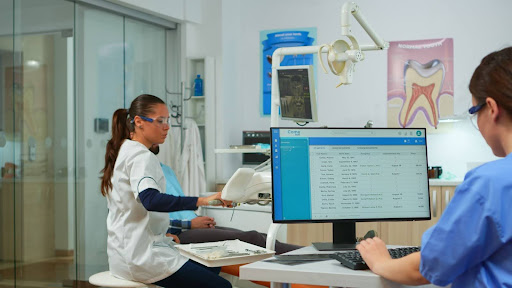
You’ll find that practical steps, such as having effective ventilation systems, using the correct gloves, masks, and eye protection, and storing materials safely, go a long way towards keeping your workspace compliant and hazard-free. Did you know even your cleaning procedure—how you disinfect tools, surfaces, and even your own hands—can significantly lower the risk of disease transmission and cross-contamination?
Getting up to speed with the latest recommendations doesn’t have to be overwhelming. This guide breaks down safety protocols in a straightforward way, giving you actionable tips to make your lab safer and more efficient, whether it’s locking up chemicals or updating your emergency preparedness plan.
Core Principles of Dental Lab Safety
Maintaining a safe environment in dental laboratories requires adherence to established standards, consistent evaluation of potential hazards, and diligent record keeping. Your daily practices must align with legal requirements while prioritising prevention and transparent communication.
Regulatory Standards and Compliance
You are legally obligated to follow strict regulations to protect both staff and those affected by lab activities. In the UK, the Health and Safety at Work Act 1974 is the overarching law for workplace health, safety, and welfare.
Dental labs must ensure proper ventilation, supply and maintenance of personal protective equipment (PPE), and regular equipment servicing. Regulatory bodies, such as the General Dental Council (GDC), publish ethical standards and expect full compliance.
Tip: Schedule yearly health and safety training for all employees. Conduct spot checks to confirm everyone uses required PPE, like gloves and safety glasses.
Documentation, such as audits and inspection checklists is mandatory for regulatory inspections. Failing to comply can lead to penalties, but more importantly, it puts your team and patients at risk.
Risk Assessment in Dental Laboratories
A thorough risk assessment identifies potential dangers, such as chemical exposure, sharp instrument injuries, or repetitive strain.
Carry out risk assessments at least annually, or whenever processes change. Engage technicians in the process; their insight often uncovers overlooked risks.
Addressing ergonomic issues prevents common injuries like back and neck pain. Encourage breaks and invest in adjustable chairs and benches.
Role of Documentation in Safety Practices
Accurate records support compliance and enable rapid response in emergencies. Your documentation should include training logs, accident reports, maintenance schedules, and risk assessments.
Maintain an up-to-date logbook for health and safety procedures. This allows for quick reference during inspections and protects you legally.
Make documentation accessible and encourage staff to report incidents and near-misses immediately. Recognise and record good safety behaviour to promote a positive culture.
Hint: Digital documentation tools simplify updates and reduce lost paperwork. Set reminders to review and update records at least every six months.
Personal Protective Equipment and Hygiene Protocols
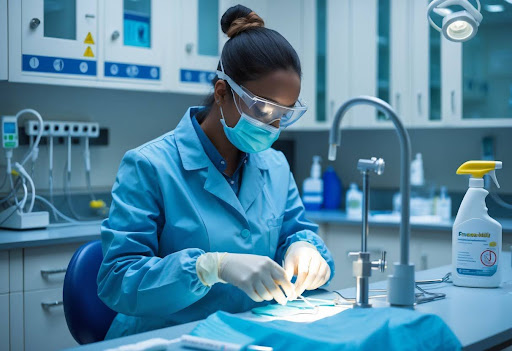
Compliance with robust personal protective equipment (PPE) and hygiene protocols is critical for maintaining dental lab safety. Preventing exposure to infectious materials and ensuring both worker and patient health requires precise adherence to recommended standards.
Types of PPE Required in Dental Labs
Every dental lab worker should have access to essential PPE. You’ll typically need protective eyewear, face masks, disposable gloves, and fluid-resistant lab coats or gowns. These items protect against droplets, splatter, chemical exposure, and sharp instruments.
Inspect your PPE before every use for rips or faults. Replace disposable items between tasks. Clean and disinfect reusable shields and eyewear after each use. Store unused PPE in a dry, uncontaminated area away from direct sunlight.
Proper Hand Hygiene Procedures
Hand hygiene is the single most effective defence against contamination in dental labs. You should wash your hands with soap and warm water for at least 20 seconds before and after every procedure or PPE change. If soap and water aren’t available, use an alcohol-based sanitiser containing at least 60% alcohol.
Use a nail brush under fingernails and avoid wearing rings or bracelets, as they can trap microbes. Hands should also be dried with disposable paper towels, not linen. Always follow these key steps:
- Wet hands thoroughly.
- Apply enough soap.
- Lather and scrub all surfaces, including wrists.
- Rinse well under running water.
- Dry completely.
Fun fact: Frequent handwashing reduces the risk of infection for lab staff by over 50%, according to studies.
Uniform and Dress Code Standards
Dress codes go beyond appearance; they’re about health. Wear dedicated lab clothing such as closed-toe shoes, full-length trousers, and disposable or autoclavable gowns. Street clothes should never be worn in the lab.
Lab uniforms should be changed daily or immediately if visibly soiled. Use separate storage areas for clean and used uniforms. Hair should be tied back, and beards covered with approved beard covers if applicable.
Avoid jewellery and long, artificial nails, as they can harbour bacteria and compromise glove integrity. Always use PPE in the correct sequence as specified in your [A Guide to Dental Lab Safety Standards] for full coverage and protection.
Safe Handling of Materials and Equipment
Proper management of materials and equipment reduces risk to you and your team. Daily routines and established procedures build a safer, healthier work environment in every dental laboratory.
Chemical and Biological Hazard Management
Dental labs work with substances that can harm both people and the environment. Always check the Material Safety Data Sheet (MSDS) for each chemical before use and follow recommended protective measures like gloves, goggles, and masks.
Separate workstations for handling acrylics, resins, acids, and disinfectants prevent cross-contamination. Never eat or drink in these zones. Simple rules, such as “treat every patient impression as potentially infectious,” help reduce exposure risk.
Mark and store biohazard waste in labelled, puncture-resistant containers. Disinfect tools in direct contact with impressions or tissue using an approved method, but avoid physical sterilisation that may damage non-metal materials. Spills should be cleaned immediately with suitable agents, and hands washed thoroughly before touching other surfaces.
Equipment Maintenance and Safety
Regular inspection and servicing of equipment prevent malfunctions and accidents. Create a maintenance log and update it each time you check, clean, or repair handpieces, lathes, or casting machines.
Unplug electrical items before maintenance, and check cords for fraying or damage. Install guards on rotating equipment and ensure dust extraction systems work, especially when grinding or polishing materials that release fine particles. Use ear protection in high-noise areas.
Train all new staff on the safe operation of every machine they may use in the lab. Emergency stop buttons and fire extinguishers should be easy to reach. If you spot odd smells, sparks, or noises, switch the machine off and report it at once.
Material Storage Guidelines
Organise raw materials by hazard type and manufacturer guidance. Flammable substances—like certain adhesives or monomers—must be kept in a flame-proof cabinet stored away from heat sources.
Keep acids and alkalis on lower shelves in chemical-resistant trays to catch spills. Store dental stones and alloys in dry, labelled bins with usage instructions visible. Rotated stock prevents waste by using older supplies first; track expiration dates on a whiteboard or storage labels.
Personal protective equipment (PPE) such as gloves and masks should be stocked in accessible locations for immediate use. An inventory system ensures you don’t run out of key safety items like eye-wash stations or spill kits.
Emergency Preparedness and Incident Response
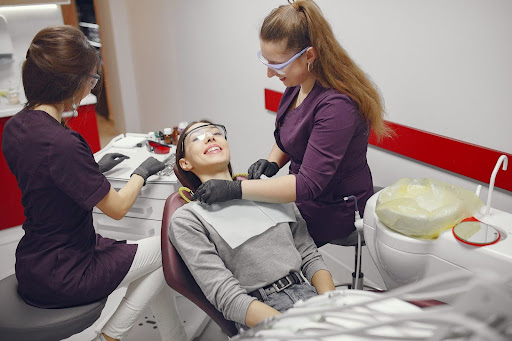
Clear planning for emergencies reduces risk in dental labs and safeguards everyone. Attention to first aid, fire procedures, and accident management makes daily handling of hazards less stressful and more effective.
First Aid Measures in Dental Labs
You need at least one fully stocked first aid kit accessible at all times, and someone on every shift who is trained in basic first aid. Typical items include sterile gauze, adhesive bandages, antiseptics, burn dressings, and eye wash. Replace any used or expired items immediately.
Place the kit in a central spot—never lock it away—to save precious seconds during an emergency. Post an up-to-date list of emergency contacts and poison control numbers next to the kit.
Regularly review and practise the correct way to treat minor burns, cuts, chemical exposures, and accidental needle sticks. Running mock drills helps your team act fast and reduces panic. For example, a trainee with a chemical splash should reach the eyewash station and flush their eyes for at least 15 minutes.
Fire Safety and Evacuation Plans
Working with flammable materials such as acrylic monomers means every dental lab must have a clear fire safety protocol. Post evacuation maps beside every exit. Explain escape routes to your team during induction and at regular fire drills, which should occur at least twice a year.
Install multi-purpose fire extinguishers rated for chemical and electrical fires in strategic locations; inspect them every six months. Unblock fire exits and keep flammable substances in sealed, labelled containers away from heat sources.
Equip the lab with smoke alarms and keep emergency lighting operational. If the alarm sounds, your team should evacuate calmly and gather at a predetermined assembly point, calling the fire brigade as soon as possible. Provide a list of responsibilities, such as checking restrooms or securing hazardous materials, to each staff member.
Reporting and Managing Accidents
Document every accident or near miss as soon as possible using an incident report form, even if the injury seems minor. Quick reporting helps identify patterns and prevent repeat hazards. Treat any wounds or exposures first, then record the details: who, what, when, where, and how it happened.
Encourage your team to report all incidents without fear of blame. Review these reports in staff meetings to refine your safety procedures. Store completed incident forms securely but keep them readily accessible for inspections or audits.
Develop clear follow-up protocols to monitor recovery, provide extra training, or update equipment as needed. Put up guidance posters that highlight reporting steps—they serve as constant visual reminders for your team.
Ongoing Safety Training and Culture
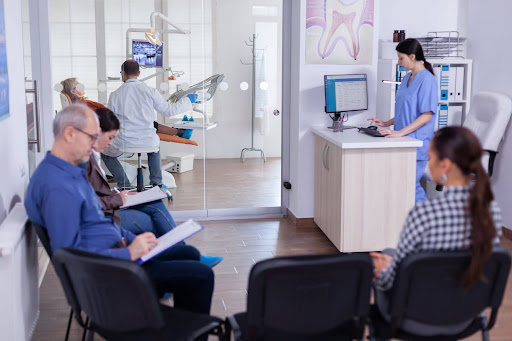
Consistent safety training ensures your dental laboratory remains current with regulations, technologies, and best practices. Active engagement in ongoing education, regular audits, and a strong safety-first mindset limit workplace incidents and foster accountability.
Implementing Continuous Education
Continuous education forms the backbone of safe dental lab practice. New hazards, equipment, and protocols emerge each year, making it vital that you update your knowledge frequently. Keep team members informed by enrolling them in accredited safety courses, inviting industry experts for on-site demonstrations, or using online learning platforms.
Hint: Schedule short, focused training every quarter to keep information fresh without overwhelming your team.
Cover essential topics such as hazardous materials handling, proper use of personal protective equipment (PPE), and emergency procedures. You can use interactive tools like quizzes or hands-on drills for better retention.
Fun fact: Labs that maintain monthly safety briefings report fewer minor accidents than those that do yearly sessions. This hands-on, ongoing approach keeps everyone vigilant, whether it’s handling acrylic dust or sharp instruments.
Periodic Safety Audits
Regular audits help identify gaps in your lab’s safety protocols. Conduct internal checks at least twice a year to review compliance with safety standards, including the Care Quality Commission (CQC) and Health and Safety Executive (HSE) requirements.
Tip: Share audit outcomes openly so that your team knows what has improved and what still needs work. Audits can be made less intimidating by involving all lab personnel in a collaborative review, looking together at fire exits, chemical storage, or handwashing facilities.
Frequent audits reduce your liability exposure and let you respond quickly to changing standards, such as updates to dental equipment regulations in 2025.
Promoting a Culture of Safety
Building a culture of safety means that safety is second nature to everyone in your lab. Begin by designating a safeguarding lead responsible for daily oversight and regular communication of policies. Ensure safety concerns can be raised confidentially without the fear of negative consequences.
Foster open discussions about near-misses and incidents, using them as learning tools rather than assigning blame. Recognise and reward your team’s good safety behaviours—monthly certificates or simple thank-you notes can increase engagement.
Regular updates on new industry guidance, visible safety signage, and easy access to incident reporting channels reinforce good habits. Team meetings that include brief safety check-ins help to keep safety at the forefront of daily operations.
Encouraging accountability at every level leads to measurable improvements in both staff well-being and patient safety outcomes.
Frequently Asked Questions
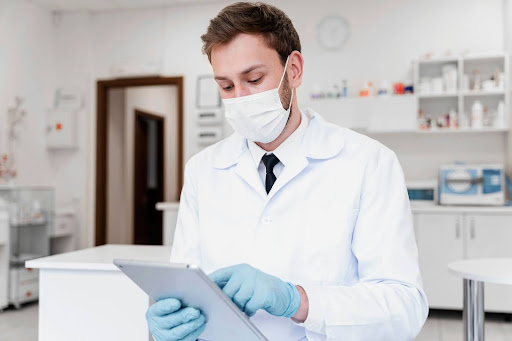
Dental laboratories must meet rigorous safety standards because of exposure to chemical, biological, and physical risks. Understanding the details of legal requirements, daily hazards, and best practices helps you create a safer environment for everyone involved.
What are the key components of a dental laboratory safety programme?
A solid safety programme includes written protocols for handling hazardous substances, using personal protective equipment (PPE), and maintaining emergency equipment like eyewash stations. You should also ensure regular safety training, proper waste disposal, and routine checks of ventilation systems.
Having a designated health and safety lead provides a clear point of contact for any concerns or incidents.
How does health and safety legislation in the UK apply to dental practices?
In the UK, dental practices and labs must comply with the Health and Safety at Work Act, Control of Substances Hazardous to Health (COSHH), and Reporting of Injuries, Diseases and Dangerous Occurrences Regulations (RIDDOR).
You need to follow strict recordkeeping, risk assessments, and ensure safe storage of chemicals and equipment. Failure to comply can lead to both legal penalties and risks of harm.
What are the specific risks associated with working in a dental lab and how can they be mitigated?
Dental lab workers face risks from sharp tools, airborne dust, toxic chemicals, and potential biological agents. For instance, breathing in silica dust from grinding models can lead to long-term lung issues.
Mitigate risks by wearing correct PPE like masks and gloves, using extraction fans to control dust, and regularly disinfecting surfaces. Keep sharps containers accessible and handle chemicals in well-ventilated areas to avoid accidental exposure.
What workplace policies should a dental nurse be aware of to ensure safety?
You should know your lab’s infection control policies, how to identify faulty equipment, and procedures for reporting incidents. Familiarise yourself with fire safety routes and how to use eyewash stations.
Regular hand hygiene and careful labelling of materials help prevent cross-contamination. Staying current with ongoing safety training is also essential.
How frequently should risk assessments be conducted in dental laboratories?
Risk assessments should occur at least annually or whenever a significant change happens, such as new equipment installation or procedure updates. If there is a near-miss or incident, review and update your assessment promptly.
Keep written records of completed risk assessments and actions taken. This helps prove diligence and track recurring hazards over time.
What are the safety at work regulations that particularly pertain to dental settings?
Besides the Health and Safety at Work Act and COSHH, be aware of regulations around bloodborne pathogens, manual handling, and safe use of electrical and mechanical equipment. The Provision and Use of Work Equipment Regulations (PUWER) apply, so only trained staff should operate certain machines.
Always carry out regular checks on autoclaves, ventilation, and security measures in areas with controlled substances. Ensure emergency contact information is posted somewhere visible at all times.





